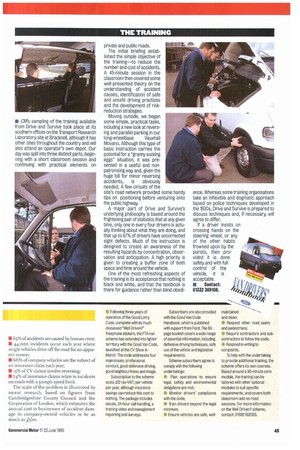DRI YE AND SURVIVE
Page 46

Page 47

If you've noticed an error in this article please click here to report it so we can fix it.
One of the main themes of the large goods vehicle scene recently has been the increased emphasis on driver training, but much of it seems to have passed the van world by. We've all heard the apocryphal stories 1 about White Van Man, and can probably add a few of our own.
o
EL There's no doubt that frantic delivery schedules in an unregulated environment can lead
."'. to frustration, and in turn to bullying and ,
I aggressive driving with an inevitably ‹ r= increased accident rate.
0 A number of factors are looming which are 0 I likely to affect the standard of van driving. Hardening of attitudes and legislation relating to corporate liability are likely to place the responsibility for driving standards increasingly on the employer.
At the same time, the NHS is being actively encouraged by the Government to recover the Full costs of post-accident medical attention from the casualties.
As the burden is likely to fall on the insurance companies, these august bodies are beginning to force the issue of advanced training for van drivers. A number of companies are already quoting two premium levels; one for fleets providing advanced training; and another, considerably less attractive, for those with no training policy.
To see how van driver training can help, CM sampled the services of one of the leading training providers, Drive and Survive. The organisation has a i2-year history with much of its early work being done in conjunction with Ford; one major task being the provision of training for drivers of the high-performanceCosworth models.
It now claims to be the largest post-drivingtest training organisation in Europe, drawing on a pool of more than 90 trainers, around a third of whom are LGV-qualified.
Before spending hard-earned cash on training, operators will inevitably ask "why train?" Out of a mountain of available statistics, just a small selection may help to convince them: • 65% of accidents are caused by human error; • 44,000 incidents occur each year where single vehicles drive off the road for no apparent reason;
• 6 6% of company vehicles are the subject of an insurance claim each year;
• 15% of CV claims involve reversing; • 74% of insurance claims relate to incidents on roads with a 30mph speed limit.
The scale of the problem is illustrated by recent research, based on figures from Cambridgeshire County Council and the Corporation of London, which estimates the annual cost to businesses of accident damage to company-owned vehicles to be as much as 15bn.
III Following three years of operation of the Good Lorry Code, complete with its much discussed 'Well Driven?" freephone stickers, the FTA-run scheme has extended into lighter territory with the Good Van Code, launched at the CV Show in March. The code addresses four main issues: professional conduct, good defensive driving, good neighbourliness and image.
Subscription to the scheme costs £12 (ex-VAT) per vehicle per year, although insurance savings can reduce this cost to nothing. The package includes decals, 24-hour call handling, a training video and management reporting and surveys.
Subscribers are also provided with the Good Van Code Handbook, which is published with support from Ford. The 50page booklet covers a wide range of essential information, including defensive driving techniques, safe use of the vehicle and legislative requirements.
Scheme subscribers agree to comply with the following undertakings: • Plan operations to ensure legal, safety and environmental obligations are met; • Monitor drivers' compliance with the code; • Train drivers beyond the legal minimum; • Ensure vehicles are safe, well maintained and clean;
• Respect other road users and pedestrians;
• Require contractors and subcontractors to follow the code; • Respond in writing to complaints.
To help with the undertaking to provide additional training, the scheme offers its own courses. Based around a 90-minute core module, the training can be tailored with other optional modules to suit specific requirements, and covers both classroom and on-road
sessions. For more information on the Well Driven? scheme, contact: 01892 552355.
















































































































